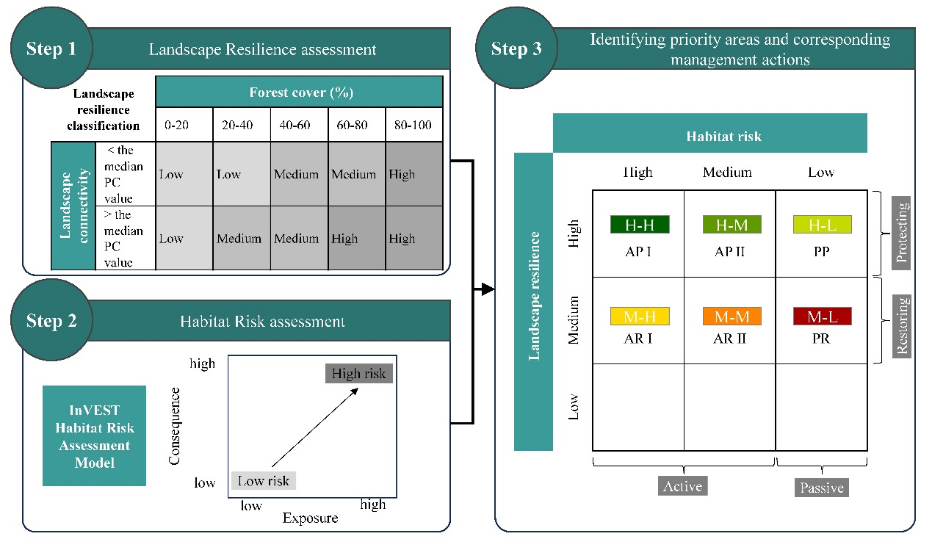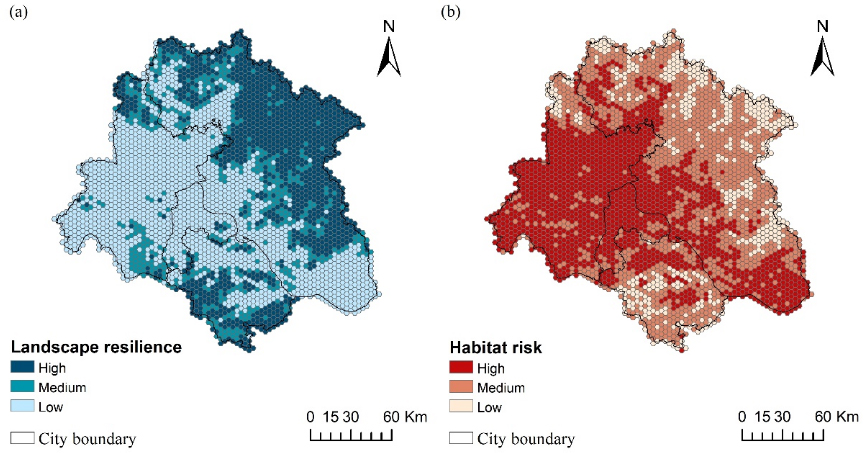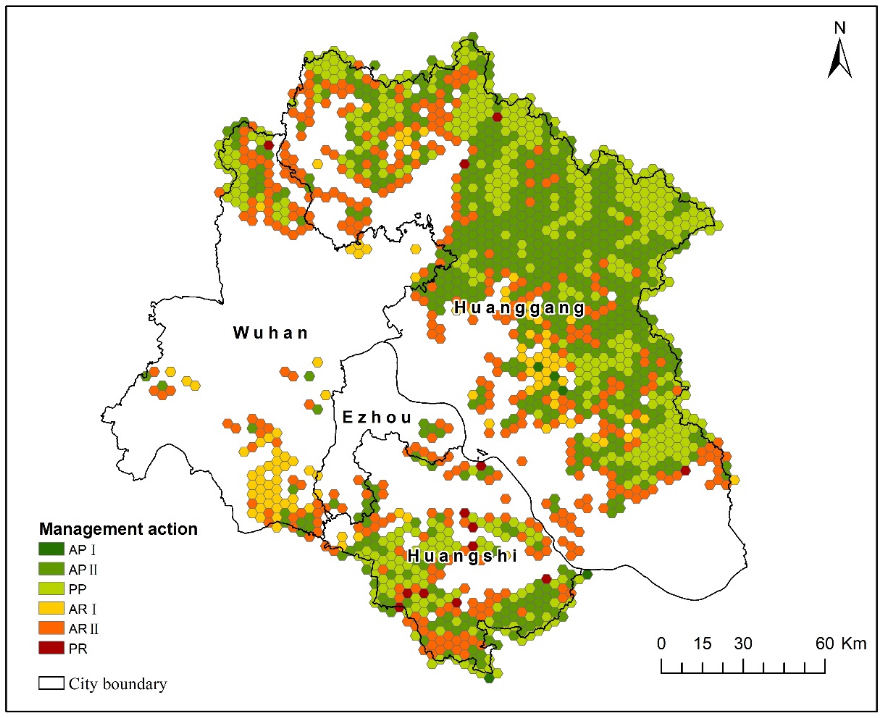南湖新闻网讯(通讯员 谭传东)近日,我校风景园林学科城市生态健康诊断与蓝绿空间效能优化创新团队吴雪飞教授课题组,在森林保护与修复规划方面取得新进展,研究成果以“Integrating habitat risk and landscape resilience in forest protection and restoration planning for biodiversity conservation”为题在城市研究与风景园林领域国际顶级学术期刊Landscape and Urban Planning上发表。
森林是地球上陆地生物多样性最丰富的区域,但却不断受到人类活动的威胁。越来越多的证据表明,保护区的建立可以防止生境的丧失,但不一定能保证物种种群的增长,单纯扩大森林面积也不一定能带来生物多样性的改善或自然生态系统的恢复。因为保护区内外的直接和间接人为干扰会导致物种丧失和生境退化。因此,为了提高生物多样性保护成效,需要采取积极主动且有效的管理措施来应对不断增加的退化风险,而不仅仅是维持森林覆盖。然而,很少有研究探讨如何通过将风险信息纳入森林保护和恢复规划,为多元化的管理行动提供空间信息。
该研究提出了一个以生物多样性保护为导向的森林保护和修复规划框架,该框架将景观韧性和生境风险评估相结合,旨在确定多元化管理行动的优先区域。该框架包括三个关键步骤:i)基于森林数量和功能连通性评估景观韧性,ii)使用InVEST模型评估生境风险,iii)通过景观韧性和生境风险之间的空间叠加分析识别优先区域和相应的管理行动。研究整合了四大类管理行动,包括主动保护(active protection,AP)、被动保护(passive protection,PP)、主动修复(active restoration,AR)和被动修复(passive restoration,PR)。其中根据风险等级又分别将AP和AR分为Ⅰ和Ⅱ两个优先级。API对应高韧性-高风险区域;APII为高韧性-中风险区域,PP为高韧性-低风险区域;ARI即中韧性-高风险;ARII为中韧性-中风险;PR为中韧性-低风险区域。

基于景观韧性和生境风险评估的森林保护与修复规划框架
研究以武汉都市圈核心区为例,将其划分为3307个规划单元。结果表明,研究区域近一半的森林面临中度至高度退化的风险,说明急需采取积极和有效的管理措施。具体而言,在API、APII和PP区域,规划单元的数量分别为5、631和498个,分别涵盖了32.89、5023.72和4593.79平方公里的残存森林生境。在ARI、ARII和PR区域,分别有106、402和13个规划单元,相应涵盖了497.11、2013.98和70.10平方公里的残存森林。分区规划结果将为武汉都市圈核心区森林规划和管理提供决策支持与建议,以提升区域森林生物多样性保护成效。

景观韧性(a)和生境风险(b)评估结果

森林保护和修复的关键区域和管理行动类型
总体而言,该项研究强调了通过整合差异化的管理行动和全面的保护和修复规划来改善生物多样性保护的结果和成本效益的潜力。基于该视角,研究团队开发了一个协调多元管理措施的森林规划框架,以最大限度地提高管理行动的成果、成本效益和互补性。研究进一步丰富了生物多样性保护视角下的森林规划理论与方法。
该研究得到了国家自然科学基金的资助。园艺林学学院风景园林系博士研究生谭传东为论文第一作者,吴雪飞教授为论文通讯作者,博士研究生徐博和洪歌为共同作者。
审核人:吴雪飞
英文摘要:
Forests, which harbor most of Earth's terrestrial biodiversity, have been and continue to be impacted by significant threats from human activities. Improving biodiversity conservation outcomes requires proactive and effective management actions to address the increasing risks, rather than merely maintaining forest cover. However, few studies have explored how to spatially inform diversified management actions by incorporating risk information into forest protection and restoration planning. Here, we propose an integrated framework for planning forest protection and restoration that integrates landscape resilience and habitat risk assessment, aiming to identify priority areas for diversified management actions, including active protection (AP), passive protection (PP), active restoration (AR), and passive restoration (PR). This framework consists of three key steps: i) evaluating landscape resilience based on forest amount and functional connectivity, ii) assessing habitat risk using the InVEST model, and iii) identifying priority areas and corresponding management actions by spatial overlap analysis between landscape resilience and habitat risk. Using the central region of the Wuhan Metropolitan Area as a case study, we divided it into 3307 planning units, referred to as Focal Landscapes (FLs). The results indicate that there are 636 FLs in the AP zone, 498 in the PP zone, 508 in the AR zone, and 13 in the PR zone. This research demonstrates how effectively integrating risk considerations can enhance the planning process and outcomes. This study also underscores the potential to improve the outcome and cost-effectiveness of biodiversity conservation through the formulation of differentiated management actions and comprehensive planning for protection and restoration.